备注
单击 here 下载完整的示例代码或通过活页夹在浏览器中运行此示例
LI阈值¶
1993年,Li和Lee提出了一种新的标准来寻找区分图像背景和前景的最佳阈值 1. 他们建议,尽量减少 cross-entropy 在大多数情况下,在前景和前景平均值之间,以及背景和背景平均值之间,将给出最佳阈值。
然而,直到1998年,找到这个阈值的方法是尝试所有可能的阈值,然后选择具有最小交叉熵的阈值。在这一点上,Li和Tam实现了一种新的迭代方法,通过使用交叉熵的斜率来更快地找到最优点 2. 这是在SCRKIT-IMAGE中实现的方法 skimage.filters.threshold_li() 。
在这里,我们用Li的迭代方法证明了交叉熵及其最优化。请注意,我们使用的是私有函数 _cross_entropy ,不应在生产代码中使用,因为它可能会更改。
- 1
李春华,李长康(1993)“最小交叉熵阈值”模式识别,26(4):617-625 DOI:10.1016/0031-3203(93)90115-D
- 2
李春华,谭平山(1998)“最小交叉熵阈值的迭代算法”,模式识别通讯,18(8):771-776 DOI:10.1016/S0167-8655(98)00057-9
首先,让我们画出 skimage.data.camera() 在所有可能的阈值下成像。
thresholds = np.arange(np.min(camera) + 1.5, np.max(camera) - 1.5)
entropies = [_cross_entropy(camera, t) for t in thresholds]
optimal_camera_threshold = thresholds[np.argmin(entropies)]
fig, ax = plt.subplots(1, 3, figsize=(8, 3))
ax[0].imshow(camera, cmap='gray')
ax[0].set_title('image')
ax[0].set_axis_off()
ax[1].imshow(camera > optimal_camera_threshold, cmap='gray')
ax[1].set_title('thresholded')
ax[1].set_axis_off()
ax[2].plot(thresholds, entropies)
ax[2].set_xlabel('thresholds')
ax[2].set_ylabel('cross-entropy')
ax[2].vlines(optimal_camera_threshold,
ymin=np.min(entropies) - 0.05 * np.ptp(entropies),
ymax=np.max(entropies) - 0.05 * np.ptp(entropies))
ax[2].set_title('optimal threshold')
fig.tight_layout()
print('The brute force optimal threshold is:', optimal_camera_threshold)
print('The computed optimal threshold is:', filters.threshold_li(camera))
plt.show()
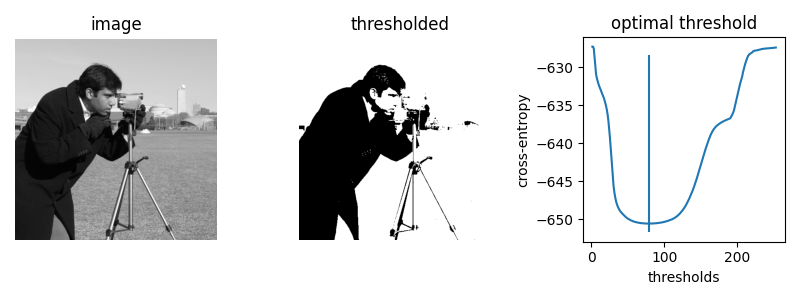
输出:
The brute force optimal threshold is: 78.5
The computed optimal threshold is: 78.91288426606151
接下来,让我们使用 iter_callback 的特点 threshold_li 来检查发生时的优化过程。
iter_thresholds = []
optimal_threshold = filters.threshold_li(camera,
iter_callback=iter_thresholds.append)
iter_entropies = [_cross_entropy(camera, t) for t in iter_thresholds]
print('Only', len(iter_thresholds), 'thresholds examined.')
fig, ax = plt.subplots()
ax.plot(thresholds, entropies, label='all threshold entropies')
ax.plot(iter_thresholds, iter_entropies, label='optimization path')
ax.scatter(iter_thresholds, iter_entropies, c='C1')
ax.legend(loc='upper right')
plt.show()
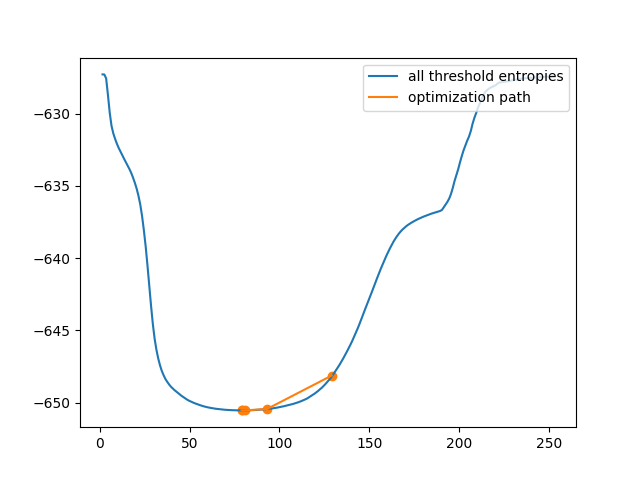
输出:
Only 5 thresholds examined.
这显然比暴力手段效率高得多。然而,在一些图像中,交叉熵不是 凸面 ,即只有一个最优解。在这种情况下,梯度下降可能会产生一个不是最优的阈值。在这个例子中,我们看到了对优化的糟糕的初始猜测如何导致糟糕的阈值选择。
iter_thresholds2 = []
opt_threshold2 = filters.threshold_li(cell, initial_guess=64,
iter_callback=iter_thresholds2.append)
thresholds2 = np.arange(np.min(cell) + 1.5, np.max(cell) - 1.5)
entropies2 = [_cross_entropy(cell, t) for t in thresholds]
iter_entropies2 = [_cross_entropy(cell, t) for t in iter_thresholds2]
fig, ax = plt.subplots(1, 3, figsize=(8, 3))
ax[0].imshow(cell, cmap='magma')
ax[0].set_title('image')
ax[0].set_axis_off()
ax[1].imshow(cell > opt_threshold2, cmap='gray')
ax[1].set_title('thresholded')
ax[1].set_axis_off()
ax[2].plot(thresholds2, entropies2, label='all threshold entropies')
ax[2].plot(iter_thresholds2, iter_entropies2, label='optimization path')
ax[2].scatter(iter_thresholds2, iter_entropies2, c='C1')
ax[2].legend(loc='upper right')
plt.show()
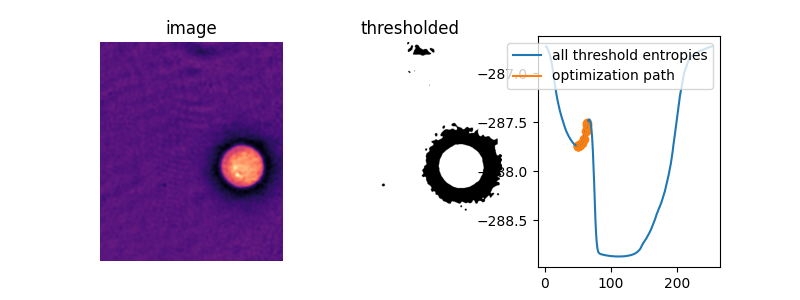
在这张图片中,令人惊讶的是, 默认设置 最初的猜测,即平均图像值,实际上是 正确的 在目标函数的两个“谷”之间的峰顶上。在不提供初始猜测的情况下,李的阈值方法根本不起作用!
iter_thresholds3 = []
opt_threshold3 = filters.threshold_li(cell,
iter_callback=iter_thresholds3.append)
iter_entropies3 = [_cross_entropy(cell, t) for t in iter_thresholds3]
fig, ax = plt.subplots(1, 3, figsize=(8, 3))
ax[0].imshow(cell, cmap='magma')
ax[0].set_title('image')
ax[0].set_axis_off()
ax[1].imshow(cell > opt_threshold3, cmap='gray')
ax[1].set_title('thresholded')
ax[1].set_axis_off()
ax[2].plot(thresholds2, entropies2, label='all threshold entropies')
ax[2].plot(iter_thresholds3, iter_entropies3, label='optimization path')
ax[2].scatter(iter_thresholds3, iter_entropies3, c='C1')
ax[2].legend(loc='upper right')
plt.show()
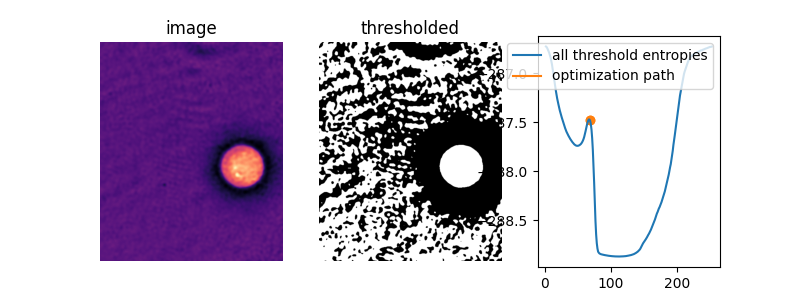
为了了解情况,让我们定义一个函数, li_gradient ,它复制LI方法的内循环并返回 变化 从当前阈值到下一个阈值。当这个梯度为0时,我们处于所谓的 驻点 Li返回此值。当它是负值时,下一次门槛猜测会更低,当它是正数时,下一次猜测会更高。
在下面的图中,我们显示了当初始猜测在 正确的 在该熵峰值的一侧。我们覆盖阈值更新渐变,通过以下方式标记0渐变线和默认初始猜测 threshold_li 。
def li_gradient(image, t):
"""Find the threshold update at a given threshold."""
foreground = image > t
mean_fore = np.mean(image[foreground])
mean_back = np.mean(image[~foreground])
t_next = ((mean_back - mean_fore) /
(np.log(mean_back) - np.log(mean_fore)))
dt = t_next - t
return dt
iter_thresholds4 = []
opt_threshold4 = filters.threshold_li(cell, initial_guess=68,
iter_callback=iter_thresholds4.append)
iter_entropies4 = [_cross_entropy(cell, t) for t in iter_thresholds4]
print(len(iter_thresholds4), 'examined, optimum:', opt_threshold4)
gradients = [li_gradient(cell, t) for t in thresholds2]
fig, ax1 = plt.subplots()
ax1.plot(thresholds2, entropies2)
ax1.plot(iter_thresholds4, iter_entropies4)
ax1.scatter(iter_thresholds4, iter_entropies4, c='C1')
ax1.set_xlabel('threshold')
ax1.set_ylabel('cross entropy', color='C0')
ax1.tick_params(axis='y', labelcolor='C0')
ax2 = ax1.twinx()
ax2.plot(thresholds2, gradients, c='C3')
ax2.hlines([0], xmin=thresholds2[0], xmax=thresholds2[-1],
colors='gray', linestyles='dashed')
ax2.vlines(np.mean(cell), ymin=np.min(gradients), ymax=np.max(gradients),
colors='gray', linestyles='dashed')
ax2.set_ylabel(r'$\Delta$(threshold)', color='C3')
ax2.tick_params(axis='y', labelcolor='C3')
fig.tight_layout()
plt.show()
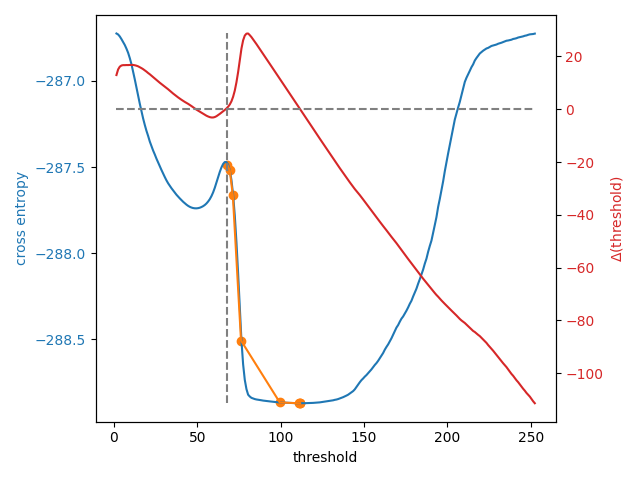
输出:
8 examined, optimum: 111.68876119648344
除了允许用户提供数字作为初始猜测之外, skimage.filters.threshold_li() 可以接收根据图像强度进行猜测的函数,就像 numpy.mean() 默认情况下为。当需要处理许多不同范围的图像时,这可能是一个很好的选择。
def quantile_95(image):
# you can use np.quantile(image, 0.95) if you have NumPy>=1.15
return np.percentile(image, 95)
iter_thresholds5 = []
opt_threshold5 = filters.threshold_li(cell, initial_guess=quantile_95,
iter_callback=iter_thresholds5.append)
iter_entropies5 = [_cross_entropy(cell, t) for t in iter_thresholds5]
print(len(iter_thresholds5), 'examined, optimum:', opt_threshold5)
fig, ax1 = plt.subplots()
ax1.plot(thresholds2, entropies2)
ax1.plot(iter_thresholds5, iter_entropies5)
ax1.scatter(iter_thresholds5, iter_entropies5, c='C1')
ax1.set_xlabel('threshold')
ax1.set_ylabel('cross entropy', color='C0')
ax1.tick_params(axis='y', labelcolor='C0')
plt.show()
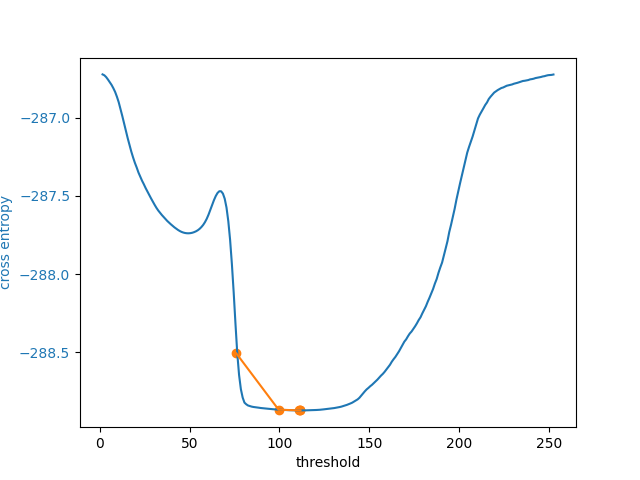
输出:
5 examined, optimum: 111.68876119648344
脚本的总运行时间: (0分4.824秒)

 Source
Source